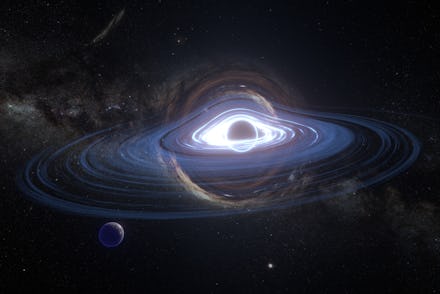Scientists think there might be black hole "factories" at the center of our galaxies

Black holes are mysterious, massive objects in space that can grow larger than you can possibly fathom. They're invisible to the human eye, extremely dangerous, and equally as fascinating as they are detrimental to any life that's unlucky enough to get near one. But there are still many things that scientists aren't exactly sure of when it comes to black holes, like how some of them grew to be so large. It's possible that they've simply merged together over years, as some previous studies have revealed. But new theories are suggesting that there's an interesting twist to how the holes are formed: enormous black hole "factories" at the center of large galaxies.
Discoveries by way of the Laser Interferometer Gravitational-Wave Observatory (LIGO) have uncovered several strangely large pairs of black holes since 2015, and using that information, scientists have woven theories that these massive black holes and the pairings of black holes together have been brewing at the core of already-massive galaxies, and that these areas can be credited with the "manufacture" of these space objects.
But how are the black holes forming in said galaxies? Essentially, disks of gas referred to as active galactic nuclei spend time swirling around supermassive black holes, as the theories go. Since the gas is always present, the cores of the galaxies could be forming the "seeds" of black holes indefinitely. Scientists have yet to detect enough of these massive holes seemingly birthed this way for any sort of conclusive evidence, but there are "hints" out there that point to "factory" black hole creation.
In fact, many black hole mergers in the universe are believed to be one-off creations that happen because of the death of stars with large mass. But if the disks of gas are still creating these bizarrely large black holes, we should start seeing more of them around when scientists take a closer look for observation. That's why they're on the lookout by way of LIGO for collisions between whirling black holes and mergers between stars of a certain size.
"If you see a single event with 80 solar masses, that’s a strong signature of some exotic formation channel," astrophysicist Davide Gerosa of the University of Birmingham in England explained. Just recently, scientists found three supermassive black holes that merged together, which brought three galaxies into one cosmic object.
The galaxy NGC 6240 was determined to have the three supermassive black holes working as one enormous space anomaly, with three different "nodes" and two of the black holes accumulating matter, with the third one remaining dormant. Each black hole was estimated to be the weight of over 90 million of our suns. This data is throwing some of what scientists utilizing LIGO have been working on decoding out of whack, but nothing's ever perfect when it comes to studying black holes or their origins.
Until there's more conclusive evidence, researchers will be considering the many different ways all of these objects in space end up being brought into existence. There isn't a way to distinguish whether some of the black holes created by active galactic nuclei are one-off events just yet, but a definitive method is currently in the works. Just chalk this up as another cosmic mystery that, when and if it's solved, will hopefully offer scientists a bigger picture of what's really going on out there in space. Then, there are only about a million other questions to mark off the list.